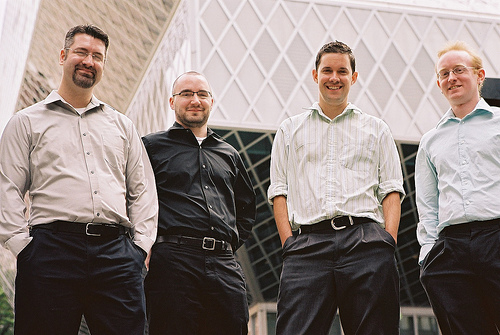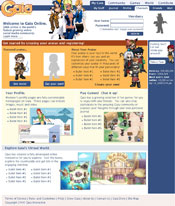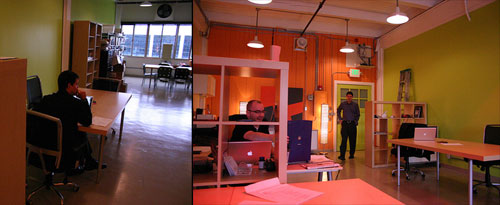
This month’s New Founders Participant hails from the Northwest region of America. Blue Flavor captures the essence of entrepreneurship and small business, electing to impose a work-life balance that’s eluded them at previous jobs. We talk with founder Brian Fling about the Blue Flavor’s adventures as a small business in its first year of operation.
Company: Blue Flavor
Location: Seattle, WA
Services: Interactive Strategy, User Research, Information Architecture, Design and Development
Tell us a bit about Blue Flavor. When was the company founded? What are your primary areas of expertise and service offerings?
We publicly opened our doors in October 2005. When we started with this concept of being the “anti-agency agency,” providing all the advantages of an agency while removing all the smoke and mirrors, and providing total transparency into our internal processes and operations.
We’ve struggled to be able to summarize Blue Flavor in one sentence. Our favorite way to describe ourselves at trade shows is “the biggest bubble gum distributor in the Northwest.” We’ve tried things like “Experience Design” or “Interactive Agency” but we like remove jargon whenever possible, so for now we’ll go with: “we make websites… and other stuff.”
Our primary areas of expertise are anything Web, Mobile, Online Community, Accessibility, or Web Standards. While we consider ourselves to be a full service shop, our core services include interactive strategy, user research, information architecture, design and development.
We know Blue Flavor has a proper bios page, but for the sake of our readers, give us the quick run down of who’s in the company and who does what?
The founders are Nick Finck, D. Keith Robinson, Matt May and myself Brian Fling. Nick’s title is Director of User Experience, focused on Information Architecture, Usability and User Research. Nick is also our resident “Nickpicker” pointing out all the important details that we tend to forget. Keith is our Creative Director doing the majority of our visual design. Keith keeps us grounded and helps us stay productive without being a taskmaster. Matt is our Director of Technology, being our resident technologist he leads our development and accessibility tasks. And I am the Director of Strategy, I help our clients to develop their big picture and internally I get the honor of doing our business development and operations.

We also have a couple of support employees and regular contractors we work with. But we are big believers in having no A Team or B Team. We want to make sure that we provide our clients with the best team possible. While we have defined roles, we share tasks a lot. For example we all code, we all project manage, we do usability. There is a lot of cross-over among all of us.
What inspired you to start the company and go into business for yourself?
Each of us have a different personal answer, but what it really boils down to is we wanted to share our experience as a team, work on good projects with good people. We saw a real value in bringing that to the table as a company.
Not only did we see a need for our particular set of combined skills and expertise, but also that with our unique way of working that we could offer clients something beyond what they might find with traditional agencies or get from their in-house teams.
We also personally wanted to have a good work-life balance. We’d been working ourselves to the bone for others and we knew full well that if we work smart, we could have a life and do great work at the same time. So we wanted to bake that into the company so no one misses out on our lives. Having good partners and employees as well as a lot of cross-over allows us to do that.
What’s a typical day like over at Blue Flavor? Is it how you envisioned your daily lives when you first started the company? Or how has it differed as time went on?
Each of us start the day working from home and catching up on email. We don’t show up at the office till around 9 or 9:30. We do a morning huddle every morning to talk about the upcoming day and work out issues. We usually take lunch together and often get into some sort of semantical debate. And we go home by 5 PM rarely staying late in the office, we try to minimize the amount of homework anyone gets sent home with.
Life at Blue Flavor is pretty much how we envisioned it, but it doesn’t come without forcing ourselves to maintain it. We wanted to be very flexible with our time, not work ourselves to the bone and most importantly have fun. We try to deal with issues and stressful situations immediately to avoid taking anything home.
Since we started we’ve smoothed out a lot of processes. It really does take a year to sort them all out and get the ship steered in the right course.
You guys are actively expressing your views through your company’s blog. How do you view the importance and relevance of a company blog as a communication channel? What has been most important for you in getting readership and interest?
Our blog is one of the important elements of our business. That being said it can be very tough to run a business, do client work and find the time to really focus on writing articles. Our blog is not only our primary communication channel, but also serves as place for to demystify some of the elements of interactive work. We try to keep our message targeted at our clients, not ourselves, which is always harder said than done.
What is most important to getting readership and interest? writing good content. Our primary goal is to write good posts and articles, if interest or more readers follows… bonus.
What are some of your favorite online and offline small business resources for inspiration and knowledge?
Probably our biggest sources of inspiration have been peers, other business owners and mentors. For example I meet with a business advisor and my personal mentor every couple of weeks. He has been in the agency business for over 30 years and provides a lot of guidance and insight. But we talk to a lot of people, other entrepreneurs, peers working for big agencies, little agencies, in-house teams. We talk pretty openly about our challenges and try to find out what has worked for others. And adapt what works for us.
Can you briefly tell us about a couple of your most recent projects? It seems Blue Flavor delivers consulting services to both web and mobile platform?

Gaia Online is an interesting project. They’re one of the largest communities on the Web. They came to us looking for help improving the user experience of their core site. We provided creative, technical and strategic direction and lots of practical advice. They’ve got an extremely engaged audience and a highly creative and artistic in house staff, the combination of which made for a very interesting and fun project where everyone learned alot. It’s a fine example of how we like to partner with our clients as opposed to holding tight to the client/service relationship. You can read the case study here.
Yes we provided services for both web and mobile platforms, but mobile is still early for a lot of companies and it doesn’t seem like a good fit at the time, we recommend to people they wait even though it means not getting the gig. In the meantime we are trying to make it easier for others to understand and get into mobile themselves.
A while back, Blue Flavor had an excellent post on time tracking with paper. More recently, you’ve been trying Harvest for your time tracking, how has it affected your process so far?
Paper time tracking really solved a big problem for us. We used a few web-based time tracking solutions early on, but most of them resulted in error-prone billing and were difficult to manage. A big struggling point was most time-tracking solutions we looked at were focused at the individual, not the agency. Moving to paper actually required a lot less work to compile our time and billing and compare though up against project budgets.
Truth be told, we recently removed paper time tracking entirely and moved over to Harvest. After using both for a while, we found that Harvest does 99% of what we need. It has greatly reduced that amount time needed to do our billing.
The big advantages of Harvest for us:
- We’ve found that using the daily timesheet view, that there was a lot of time we weren’t billing for before.
- We track our non-billable tasks in Harvest as well which we didn’t do on paper, so we’ve been able to keep our billable percent higher as we have better visibility into how much time we were spending on non-billable tasks.
- Since we manage and budget every project in terms of hours, we can provide our clients at a glance where we are at with budget.

What do you envision the studio to be like a year from now?
Blue Flavor has some very exciting changes lined up for our second year. We’re moving into a bigger and better office in September. We will add more people, more services, more clients, more… well, you’ll see. We joking call it Blue Flavor 2.0 or Blue Flavor ßeta, but we will continue to make mistakes, just much bigger ones I’m sure.
We never pretend to have everything figured out, in fact we are pretty ignorant about a lot of business issues still, but at least we feel less clueless than we did last month. One thing is certain, we will always try to stay a small company, keeping a very close relationship with our clients, the question that we are still debating is how big can small be?
Thanks to Brian Fling of Blue Flavor for the interview. We will check back with the guys in a few months after they’ve settled into their new office.















